FIAT LINEA 2007 1.G Owners Manual
Manufacturer: FIAT, Model Year: 2007, Model line: LINEA, Model: FIAT LINEA 2007 1.GPages: 230, PDF Size: 3.31 MB
Page 191 of 230
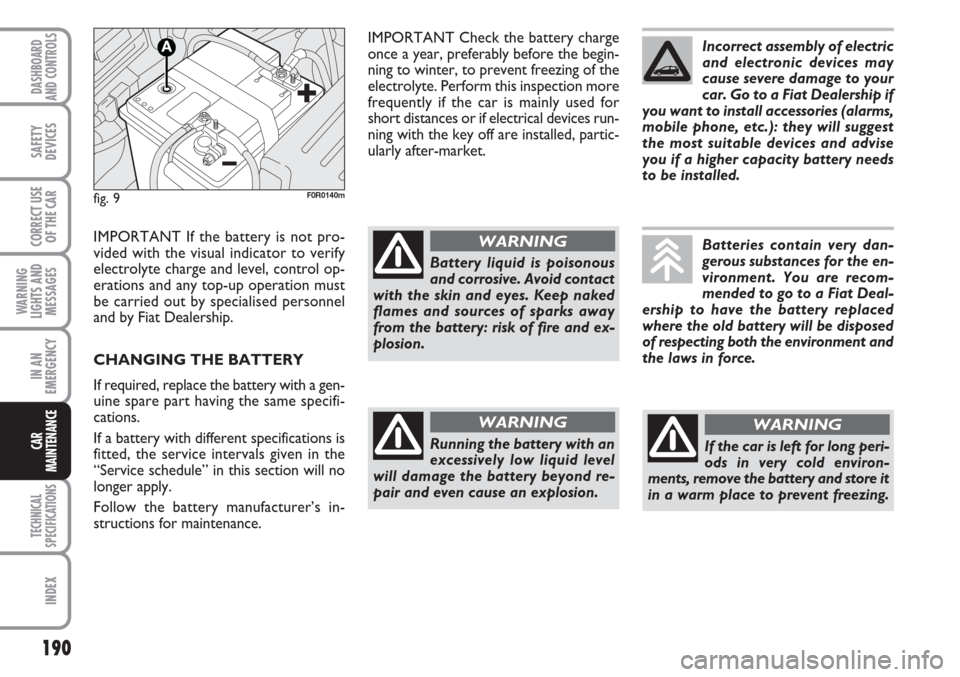
190
WARNING
LIGHTS AND
MESSAGES
TECHNICAL
SPECIFICATIONS
INDEX
DASHBOARD
AND CONTROLS
SAFETY
DEVICES
CORRECT USE
OF THE CAR
IN AN
EMERGENCY
CAR
MAINTENANCE
IMPORTANT Check the battery charge
once a year, preferably before the begin-
ning to winter, to prevent freezing of the
electrolyte. Perform this inspection more
frequently if the car is mainly used for
short distances or if electrical devices run-
ning with the key off are installed, partic-
ularly after-market.
fig. 9F0R0140m
CHANGING THE BATTERY
If required, replace the battery with a gen-
uine spare part having the same specifi-
cations.
If a battery with different specifications is
fitted, the service intervals given in the
“Service schedule” in this section will no
longer apply.
Follow the battery manufacturer’s in-
structions for maintenance.Incorrect assembly of electric
and electronic devices may
cause severe damage to your
car. Go to a Fiat Dealership if
you want to install accessories (alarms,
mobile phone, etc.): they will suggest
the most suitable devices and advise
you if a higher capacity battery needs
to be installed.
Batteries contain very dan-
gerous substances for the en-
vironment. You are recom-
mended to go to a Fiat Deal-
ership to have the battery replaced
where the old battery will be disposed
of respecting both the environment and
the laws in force.
If the car is left for long peri-
ods in very cold environ-
ments, remove the battery and store it
in a warm place to prevent freezing.
WARNING
IMPORTANT If the battery is not pro-
vided with the visual indicator to verify
electrolyte charge and level, control op-
erations and any top-up operation must
be carried out by specialised personnel
and by Fiat Dealership.
Battery liquid is poisonous
and corrosive. Avoid contact
with the skin and eyes. Keep naked
flames and sources of sparks away
from the battery: risk of fire and ex-
plosion.
WARNING
Running the battery with an
excessively low liquid level
will damage the battery beyond re-
pair and even cause an explosion.
WARNING
Page 192 of 230
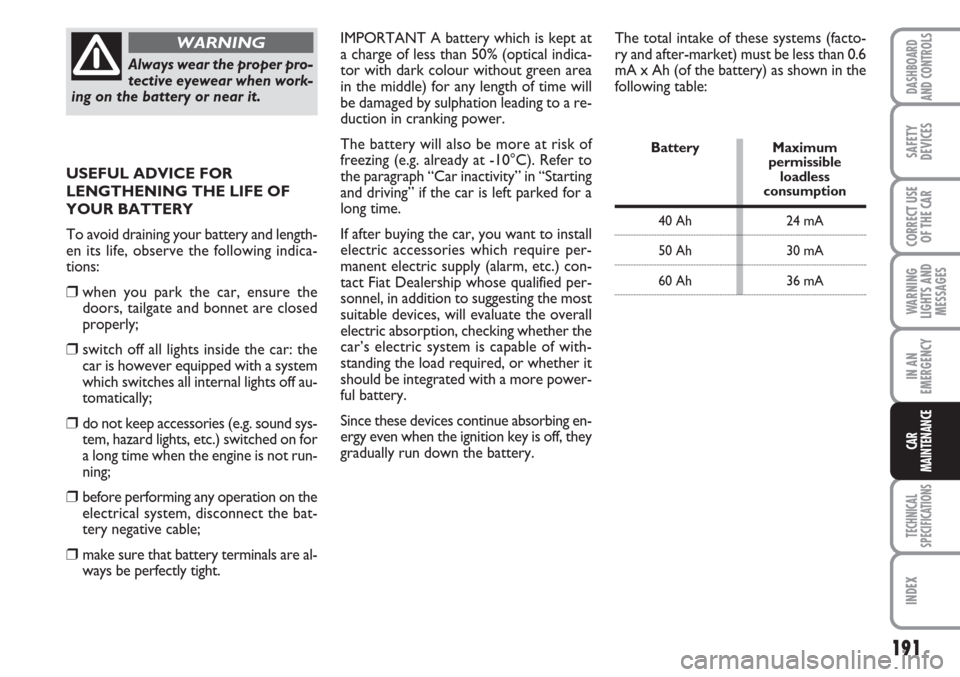
191
WARNING
LIGHTS AND
MESSAGES
TECHNICAL
SPECIFICATIONS
INDEX
DASHBOARD
AND CONTROLS
SAFETY
DEVICES
CORRECT USE
OF THE CAR
IN AN
EMERGENCY
CAR
MAINTENANCE
The total intake of these systems (facto-
ry and after-market) must be less than 0.6
mA x Ah (of the battery) as shown in the
following table:
Battery Maximum
permissible
loadless
consumption
40 Ah 24 mA
50 Ah 30 mA
60 Ah 36 mA
IMPORTANT A battery which is kept at
a charge of less than 50% (optical indica-
tor with dark colour without green area
in the middle) for any length of time will
be damaged by sulphation leading to a re-
duction in cranking power.
The battery will also be more at risk of
freezing (e.g. already at -10°C). Refer to
the paragraph “Car inactivity” in “Starting
and driving” if the car is left parked for a
long time.
If after buying the car, you want to install
electric accessories which require per-
manent electric supply (alarm, etc.) con-
tact Fiat Dealership whose qualified per-
sonnel, in addition to suggesting the most
suitable devices, will evaluate the overall
electric absorption, checking whether the
car’s electric system is capable of with-
standing the load required, or whether it
should be integrated with a more power-
ful battery.
Since these devices continue absorbing en-
ergy even when the ignition key is off, they
gradually run down the battery. USEFUL ADVICE FOR
LENGTHENING THE LIFE OF
YOUR BATTERY
To avoid draining your battery and length-
en its life, observe the following indica-
tions:
❒when you park the car, ensure the
doors, tailgate and bonnet are closed
properly;
❒switch off all lights inside the car: the
car is however equipped with a system
which switches all internal lights off au-
tomatically;
❒do not keep accessories (e.g. sound sys-
tem, hazard lights, etc.) switched on for
a long time when the engine is not run-
ning;
❒before performing any operation on the
electrical system, disconnect the bat-
tery negative cable;
❒make sure that battery terminals are al-
ways be perfectly tight.
Always wear the proper pro-
tective eyewear when work-
ing on the battery or near it.
WARNING
Page 193 of 230
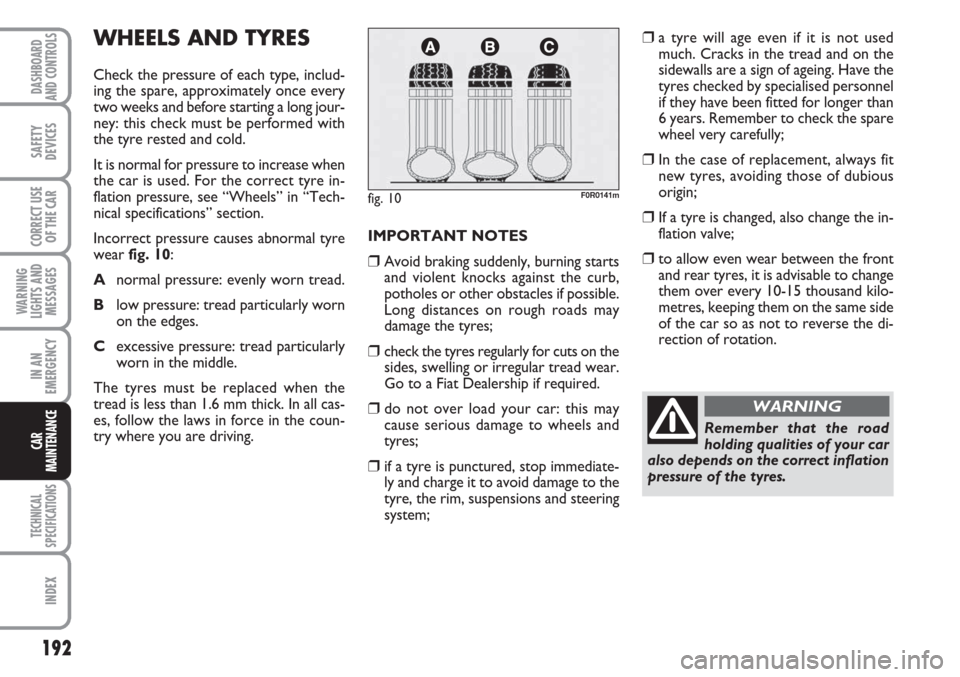
192
WARNING
LIGHTS AND
MESSAGES
TECHNICAL
SPECIFICATIONS
INDEX
DASHBOARD
AND CONTROLS
SAFETY
DEVICES
CORRECT USE
OF THE CAR
IN AN
EMERGENCY
CAR
MAINTENANCE
WHEELS AND TYRES
Check the pressure of each type, includ-
ing the spare, approximately once every
two weeks and before starting a long jour-
ney: this check must be performed with
the tyre rested and cold.
It is normal for pressure to increase when
the car is used. For the correct tyre in-
flation pressure, see “Wheels” in “Tech-
nical specifications” section.
Incorrect pressure causes abnormal tyre
wearfig. 10:
Anormal pressure: evenly worn tread.
Blow pressure: tread particularly worn
on the edges.
Cexcessive pressure: tread particularly
worn in the middle.
The tyres must be replaced when the
tread is less than 1.6 mm thick. In all cas-
es, follow the laws in force in the coun-
try where you are driving.
fig. 10F0R0141m
IMPORTANT NOTES
❒Avoid braking suddenly, burning starts
and violent knocks against the curb,
potholes or other obstacles if possible.
Long distances on rough roads may
damage the tyres;
❒check the tyres regularly for cuts on the
sides, swelling or irregular tread wear.
Go to a Fiat Dealership if required.
❒do not over load your car: this may
cause serious damage to wheels and
tyres;
❒if a tyre is punctured, stop immediate-
ly and charge it to avoid damage to the
tyre, the rim, suspensions and steering
system;
❒a tyre will age even if it is not used
much. Cracks in the tread and on the
sidewalls are a sign of ageing. Have the
tyres checked by specialised personnel
if they have been fitted for longer than
6 years. Remember to check the spare
wheel very carefully;
❒In the case of replacement, always fit
new tyres, avoiding those of dubious
origin;
❒If a tyre is changed, also change the in-
flation valve;
❒to allow even wear between the front
and rear tyres, it is advisable to change
them over every 10-15 thousand kilo-
metres, keeping them on the same side
of the car so as not to reverse the di-
rection of rotation.
Remember that the road
holding qualities of your car
also depends on the correct inflation
pressure of the tyres.
WARNING
Page 194 of 230
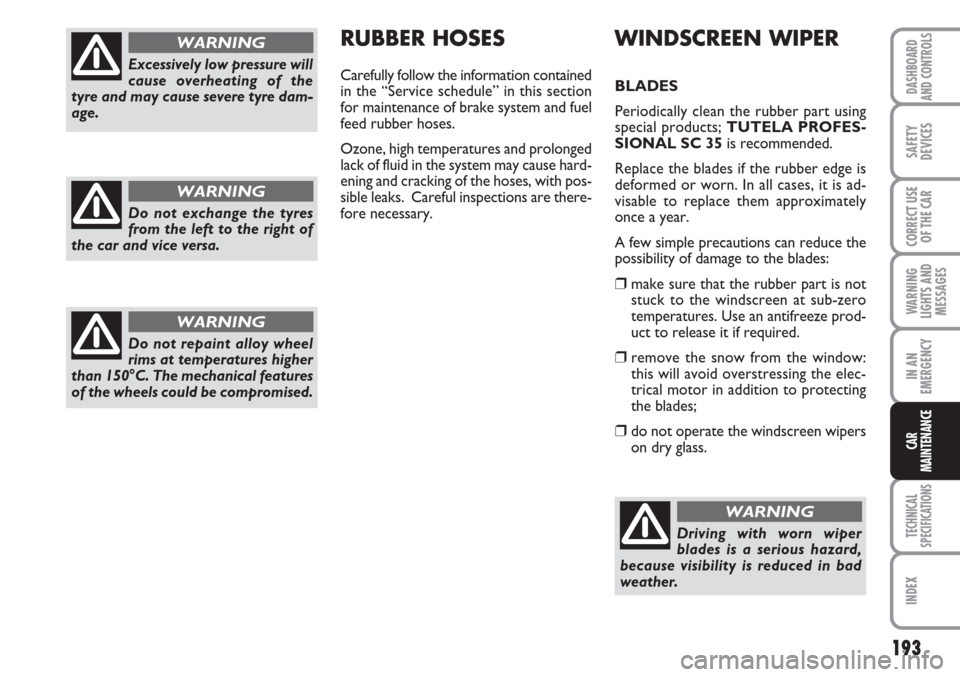
193
WARNING
LIGHTS AND
MESSAGES
TECHNICAL
SPECIFICATIONS
INDEX
DASHBOARD
AND CONTROLS
SAFETY
DEVICES
CORRECT USE
OF THE CAR
IN AN
EMERGENCY
CAR
MAINTENANCE
WINDSCREEN WIPER
BLADES
Periodically clean the rubber part using
special products; TUTELA PROFES-
SIONAL SC 35is recommended.
Replace the blades if the rubber edge is
deformed or worn. In all cases, it is ad-
visable to replace them approximately
once a year.
A few simple precautions can reduce the
possibility of damage to the blades:
❒make sure that the rubber part is not
stuck to the windscreen at sub-zero
temperatures. Use an antifreeze prod-
uct to release it if required.
❒remove the snow from the window:
this will avoid overstressing the elec-
trical motor in addition to protecting
the blades;
❒do not operate the windscreen wipers
on dry glass.
Driving with worn wiper
blades is a serious hazard,
because visibility is reduced in bad
weather.
WARNING
RUBBER HOSES
Carefully follow the information contained
in the “Service schedule” in this section
for maintenance of brake system and fuel
feed rubber hoses.
Ozone, high temperatures and prolonged
lack of fluid in the system may cause hard-
ening and cracking of the hoses, with pos-
sible leaks. Careful inspections are there-
fore necessary.Excessively low pressure will
cause overheating of the
tyre and may cause severe tyre dam-
age.
WARNING
Do not exchange the tyres
from the left to the right of
the car and vice versa.
WARNING
Do not repaint alloy wheel
rims at temperatures higher
than 150°C. The mechanical features
of the wheels could be compromised.
WARNING
Page 195 of 230
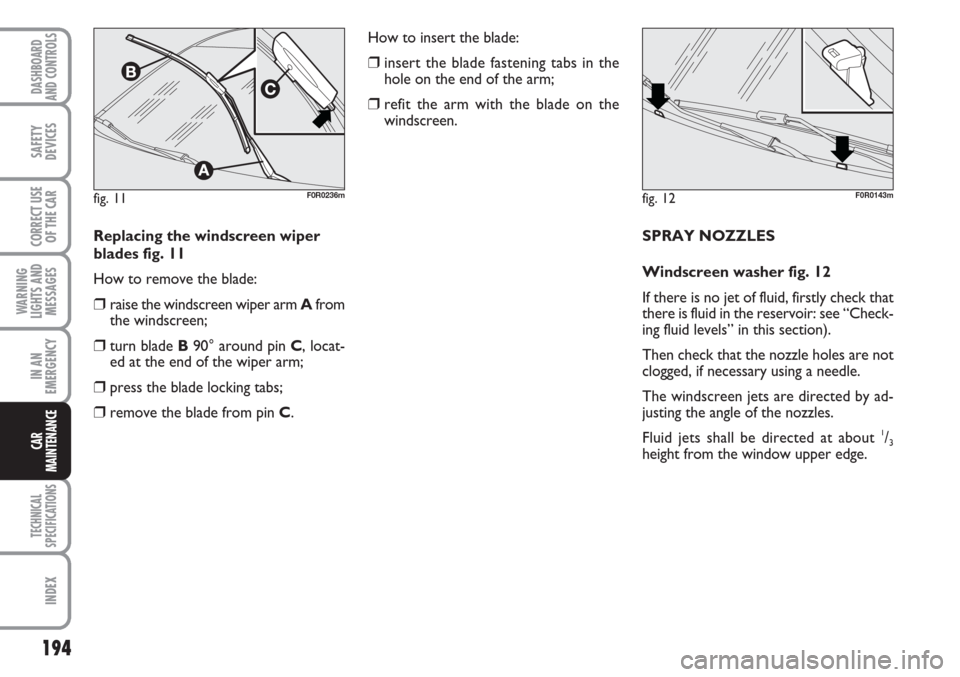
194
WARNING
LIGHTS AND
MESSAGES
TECHNICAL
SPECIFICATIONS
INDEX
DASHBOARD
AND CONTROLS
SAFETY
DEVICES
CORRECT USE
OF THE CAR
IN AN
EMERGENCY
CAR
MAINTENANCE
Replacing the windscreen wiper
blades fig. 11
How to remove the blade:
❒raise the windscreen wiper arm Afrom
the windscreen;
❒turn blade B90° around pin C, locat-
ed at the end of the wiper arm;
❒press the blade locking tabs;
❒remove the blade from pin C.
fig. 11F0R0236m
SPRAY NOZZLES
Windscreen washer fig. 12
If there is no jet of fluid, firstly check that
there is fluid in the reservoir: see “Check-
ing fluid levels” in this section).
Then check that the nozzle holes are not
clogged, if necessary using a needle.
The windscreen jets are directed by ad-
justing the angle of the nozzles.
Fluid jets shall be directed at about
1/3height from the window upper edge.
fig. 12F0R0143m
How to insert the blade:
❒insert the blade fastening tabs in the
hole on the end of the arm;
❒refit the arm with the blade on the
windscreen.
Page 196 of 230
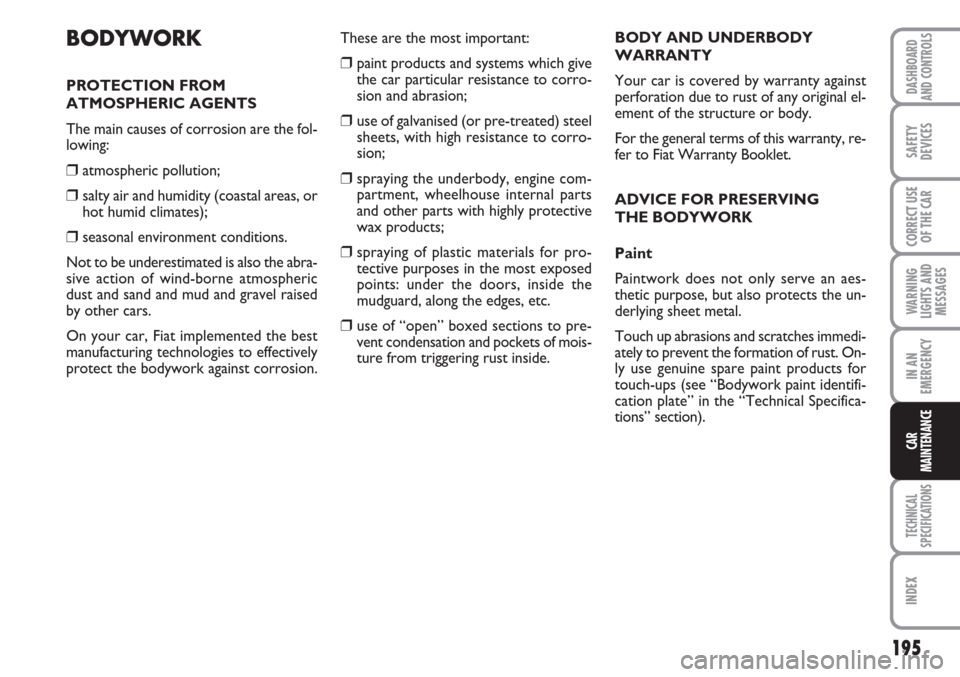
195
WARNING
LIGHTS AND
MESSAGES
TECHNICAL
SPECIFICATIONS
INDEX
DASHBOARD
AND CONTROLS
SAFETY
DEVICES
CORRECT USE
OF THE CAR
IN AN
EMERGENCY
CAR
MAINTENANCE
BODY AND UNDERBODY
WARRANTY
Your car is covered by warranty against
perforation due to rust of any original el-
ement of the structure or body.
For the general terms of this warranty, re-
fer to Fiat Warranty Booklet.
ADVICE FOR PRESERVING
THE BODYWORK
Paint
Paintwork does not only serve an aes-
thetic purpose, but also protects the un-
derlying sheet metal.
Touch up abrasions and scratches immedi-
ately to prevent the formation of rust. On-
ly use genuine spare paint products for
touch-ups (see “Bodywork paint identifi-
cation plate” in the “Technical Specifica-
tions” section).BODYWORK
PROTECTION FROM
ATMOSPHERIC AGENTS
The main causes of corrosion are the fol-
lowing:
❒atmospheric pollution;
❒salty air and humidity (coastal areas, or
hot humid climates);
❒seasonal environment conditions.
Not to be underestimated is also the abra-
sive action of wind-borne atmospheric
dust and sand and mud and gravel raised
by other cars.
On your car, Fiat implemented the best
manufacturing technologies to effectively
protect the bodywork against corrosion.These are the most important:
❒paint products and systems which give
the car particular resistance to corro-
sion and abrasion;
❒use of galvanised (or pre-treated) steel
sheets, with high resistance to corro-
sion;
❒spraying the underbody, engine com-
partment, wheelhouse internal parts
and other parts with highly protective
wax products;
❒spraying of plastic materials for pro-
tective purposes in the most exposed
points: under the doors, inside the
mudguard, along the edges, etc.
❒use of “open” boxed sections to pre-
vent condensation and pockets of mois-
ture from triggering rust inside.
Page 197 of 230
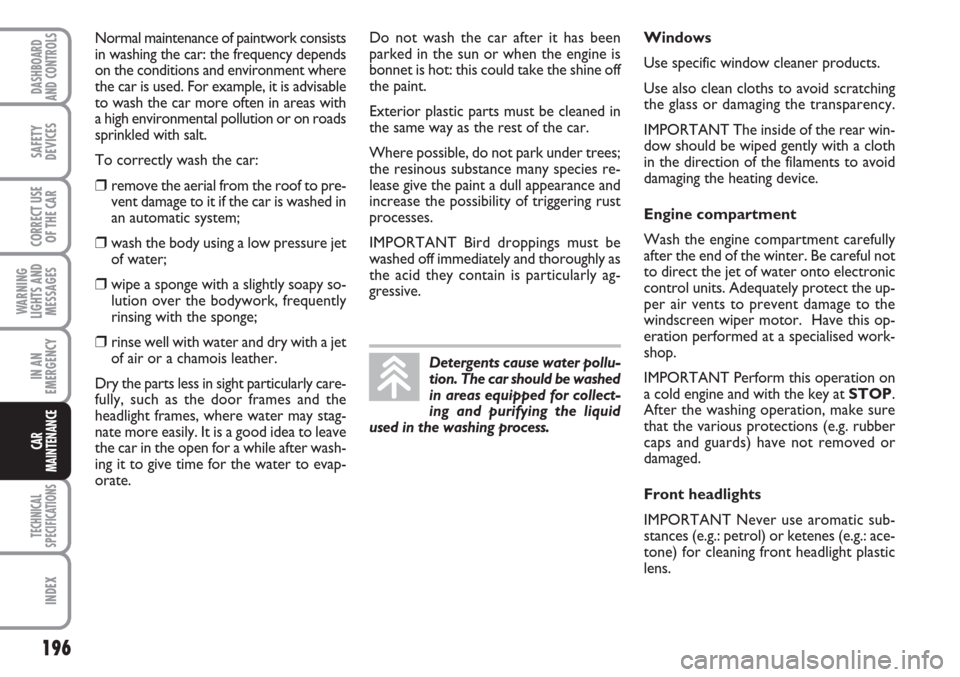
196
WARNING
LIGHTS AND
MESSAGES
TECHNICAL
SPECIFICATIONS
INDEX
DASHBOARD
AND CONTROLS
SAFETY
DEVICES
CORRECT USE
OF THE CAR
IN AN
EMERGENCY
CAR
MAINTENANCE
Normal maintenance of paintwork consists
in washing the car: the frequency depends
on the conditions and environment where
the car is used. For example, it is advisable
to wash the car more often in areas with
a high environmental pollution or on roads
sprinkled with salt.
To correctly wash the car:
❒remove the aerial from the roof to pre-
vent damage to it if the car is washed in
an automatic system;
❒wash the body using a low pressure jet
of water;
❒wipe a sponge with a slightly soapy so-
lution over the bodywork, frequently
rinsing with the sponge;
❒rinse well with water and dry with a jet
of air or a chamois leather.
Dry the parts less in sight particularly care-
fully, such as the door frames and the
headlight frames, where water may stag-
nate more easily. It is a good idea to leave
the car in the open for a while after wash-
ing it to give time for the water to evap-
orate.Do not wash the car after it has been
parked in the sun or when the engine is
bonnet is hot: this could take the shine off
the paint.
Exterior plastic parts must be cleaned in
the same way as the rest of the car.
Where possible, do not park under trees;
the resinous substance many species re-
lease give the paint a dull appearance and
increase the possibility of triggering rust
processes.
IMPORTANT Bird droppings must be
washed off immediately and thoroughly as
the acid they contain is particularly ag-
gressive.
Detergents cause water pollu-
tion. The car should be washed
in areas equipped for collect-
ing and purifying the liquid
used in the washing process.
Windows
Use specific window cleaner products.
Use also clean cloths to avoid scratching
the glass or damaging the transparency.
IMPORTANT The inside of the rear win-
dow should be wiped gently with a cloth
in the direction of the filaments to avoid
damaging the heating device.
Engine compartment
Wash the engine compartment carefully
after the end of the winter. Be careful not
to direct the jet of water onto electronic
control units. Adequately protect the up-
per air vents to prevent damage to the
windscreen wiper motor. Have this op-
eration performed at a specialised work-
shop.
IMPORTANT Perform this operation on
a cold engine and with the key at STOP.
After the washing operation, make sure
that the various protections (e.g. rubber
caps and guards) have not removed or
damaged.
Front headlights
IMPORTANT Never use aromatic sub-
stances (e.g.: petrol) or ketenes (e.g.: ace-
tone) for cleaning front headlight plastic
lens.
Page 198 of 230
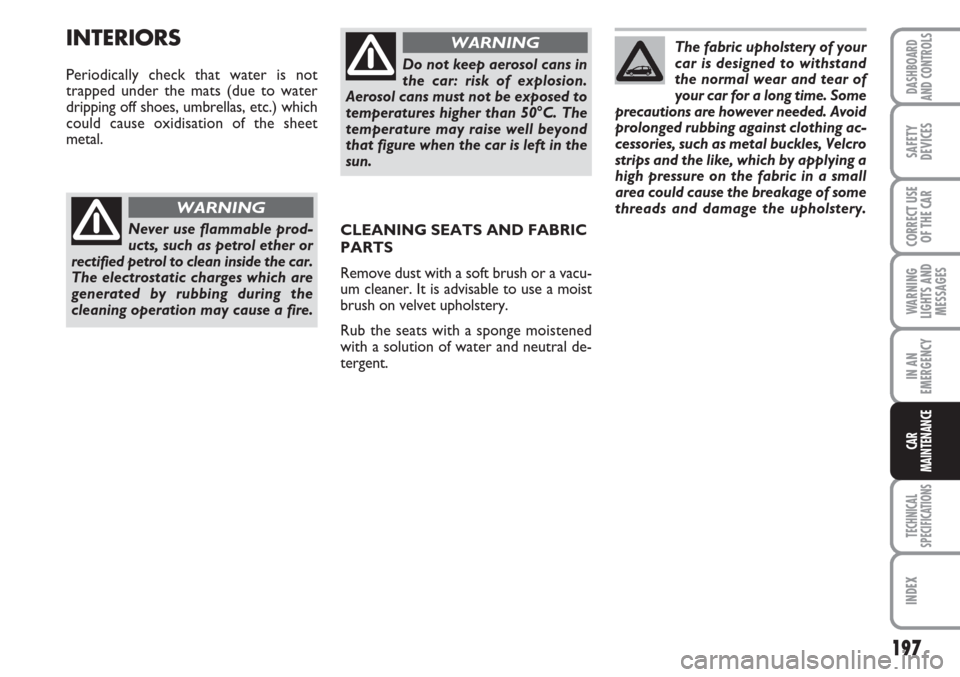
197
WARNING
LIGHTS AND
MESSAGES
TECHNICAL
SPECIFICATIONS
INDEX
DASHBOARD
AND CONTROLS
SAFETY
DEVICES
CORRECT USE
OF THE CAR
IN AN
EMERGENCY
CAR
MAINTENANCE
The fabric upholstery of your
car is designed to withstand
the normal wear and tear of
your car for a long time. Some
precautions are however needed. Avoid
prolonged rubbing against clothing ac-
cessories, such as metal buckles, Velcro
strips and the like, which by applying a
high pressure on the fabric in a small
area could cause the breakage of some
threads and damage the upholstery.
CLEANING SEATS AND FABRIC
PARTS
Remove dust with a soft brush or a vacu-
um cleaner. It is advisable to use a moist
brush on velvet upholstery.
Rub the seats with a sponge moistened
with a solution of water and neutral de-
tergent.
Never use flammable prod-
ucts, such as petrol ether or
rectified petrol to clean inside the car.
The electrostatic charges which are
generated by rubbing during the
cleaning operation may cause a fire.
WARNING
Do not keep aerosol cans in
the car: risk of explosion.
Aerosol cans must not be exposed to
temperatures higher than 50°C. The
temperature may raise well beyond
that figure when the car is left in the
sun.
WARNINGINTERIORS
Periodically check that water is not
trapped under the mats (due to water
dripping off shoes, umbrellas, etc.) which
could cause oxidisation of the sheet
metal.
Page 199 of 230
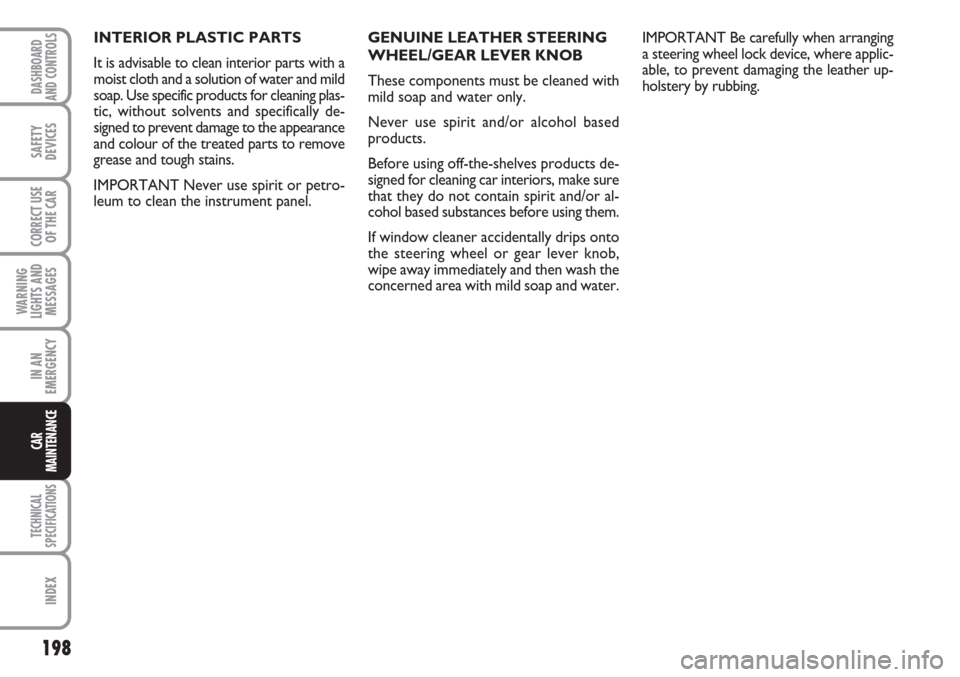
198
WARNING
LIGHTS AND
MESSAGES
TECHNICAL
SPECIFICATIONS
INDEX
DASHBOARD
AND CONTROLS
SAFETY
DEVICES
CORRECT USE
OF THE CAR
IN AN
EMERGENCY
CAR
MAINTENANCE
GENUINE LEATHER STEERING
WHEEL/GEAR LEVER KNOB
These components must be cleaned with
mild soap and water only.
Never use spirit and/or alcohol based
products.
Before using off-the-shelves products de-
signed for cleaning car interiors, make sure
that they do not contain spirit and/or al-
cohol based substances before using them.
If window cleaner accidentally drips onto
the steering wheel or gear lever knob,
wipe away immediately and then wash the
concerned area with mild soap and water. IMPORTANT Be carefully when arranging
a steering wheel lock device, where applic-
able, to prevent damaging the leather up-
holstery by rubbing. INTERIOR PLASTIC PARTS
It is advisable to clean interior parts with a
moist cloth and a solution of water and mild
soap. Use specific products for cleaning plas-
tic, without solvents and specifically de-
signed to prevent damage to the appearance
and colour of the treated parts to remove
grease and tough stains.
IMPORTANT Never use spirit or petro-
leum to clean the instrument panel.
Page 200 of 230
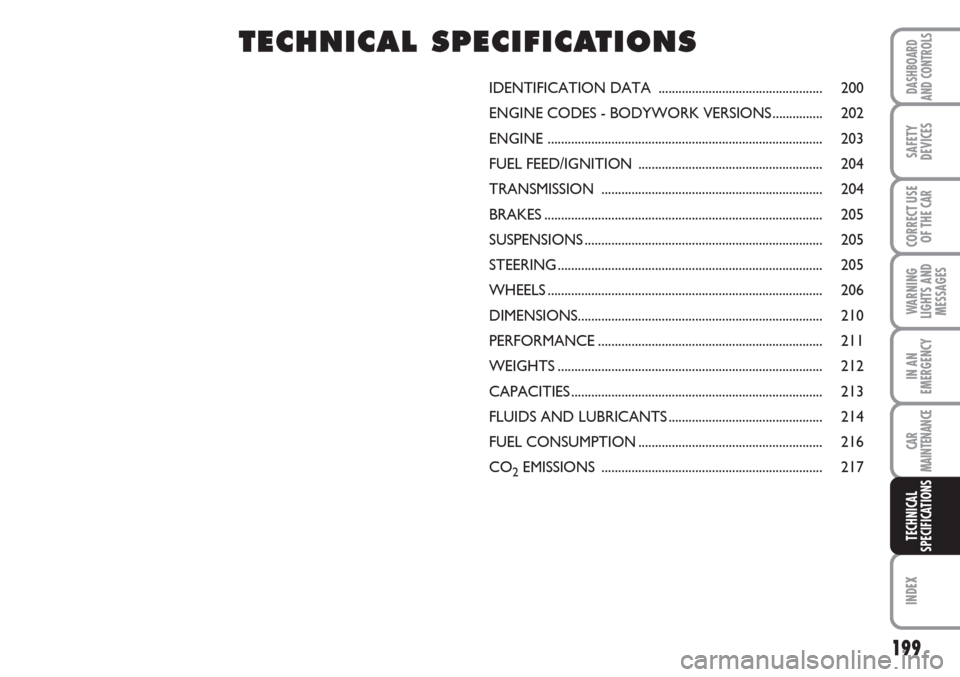
199
WARNING
LIGHTS AND
MESSAGES
INDEX
DASHBOARD
AND CONTROLS
SAFETY
DEVICES
CORRECT USE
OF THE
CAR
IN AN
EMERGENCY
CAR
MAINTENANCE
TECHNICAL
SPECIFICATIONS
IDENTIFICATION DATA ................................................. 200
ENGINE CODES - BODYWORK VERSIONS............... 202
ENGINE .................................................................................. 203
FUEL FEED/IGNITION ....................................................... 204
TRANSMISSION .................................................................. 204
BRAKES................................................................................... 205
SUSPENSIONS....................................................................... 205
STEERING............................................................................... 205
WHEELS.................................................................................. 206
DIMENSIONS......................................................................... 210
PERFORMANCE................................................................... 211
WEIGHTS............................................................................... 212
CAPACITIES........................................................................... 213
FLUIDS AND LUBRICANTS.............................................. 214
FUEL CONSUMPTION....................................................... 216
CO
2EMISSIONS .................................................................. 217
TT T
E E
C C
H H
N N
I I
C C
A A
L L
S S
P P
E E
C C
I I
F F
I I
C C
A A
T T
I I
O O
N N
S S